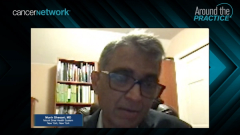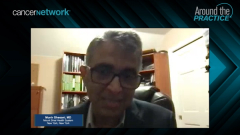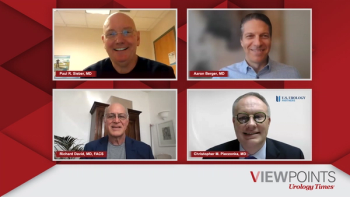
Follow-Up After Negative Bone/CT in Prostate Cancer With Molecular Recurrence
Dr Raoul Concepcion leads a multidisciplinary expert panel in a discussion about the challenges of long-term follow-up of prostate cancer in patients with negative bone/CT but positive molecular indicators of recurrence.
Episodes in this series

Raoul S. Concepcion, MD, FACS: Let’s say you have this patient, and you have a bone CTthat’s negative, and because of the low PSA [prostate-specific antigen], you have a next-generation imaging scan, whether it’s fluciclovine or PSMA [prostate-specific membrane antigen], that’s also negative. How would you follow this patient moving forward? Are you going to stick with the bone CT because it’s less expensive, it’s more available, and both scans were negative? What are you going to do on this guy?
Brian Helfand, MD, PhD: It’s one of those where it depends on the overall health and comorbidities of the patient. I don’t think that it’s unreasonable just to continue to follow the patient, especially if there are many comorbidities, and say “Hey, your PSA doubling time is very low. We’ll still follow your PSAs if you remain asymptomatic, if your PSAs remain at a very low doubling time, etc. We’ll continue to observe you.” Certainly, it’s very different in the younger, healthier patient where you want to be more aggressive. At this point, because he’s already had the radiation, it’s somewhat limiting.
On the other hand, to continue to follow the patient is certainly an option there. I do think that periodic scans are part of that observation with next-generation imaging. I certainly think, as Munir mentioned, as your PSA values get higher, the chance of you having positive scans increases. I don’t think it’s wrong to repeat those scans periodically. Alternatively, if that patient wants to be aggressive and keep things low, again, sometimes we’re treating more of a number at this point because we can’t identify where the disease is. Ultimately, you could offer hormone signaling inhibitor therapies. I’m more hesitant to do that, because sometimes changing that, until some PSA level, that becomes more uncomfortable more than anything else, but that’s still an ill-defined type space. I don’t know if that answers the question, but it’s a lot more observation.
Raoul S. Concepcion, MD, FACS: I think Judd said it perfectly. We’re trying to figure out what this means. It’s sort of like the old M0 [no metastasis detected], we know M0’s going to go away, depending upon how these scans get approved and in what clinical scenario. I’m going to conclude here, but I’m going to ask each one of you a particular question. Dr Ghesani, we’ve talked about gallium PSMA, we’ve talked about fluciclovine, and we’ve talked about C-11 choline. You also mentioned obviously F-18 FDG [fluorodeoxyglucose]. From the PSMA side specifically, what else is in the pipeline that could we expect to see over the next year or two?
Munir Ghesani, MD: There are more centers now getting access to gallium PSMA; no doubt that’ll continue to grow. Regarding several other agents, there are at least about 5 combinations, 2 gallium-based and 3 fluorine-based agents. Among all of them, the DCFPyL [fluorine F 18 DCFPyL] is farthest in the review process. It’s hard to tell with the FDA, but of all the available agents, the next one that very likely will be considered for approval, or at least in the FDA pipeline, is DCFPyL. However, there are many other agents…we participated in some of the trials and contributed close to about 50 patients. All those agents will in the very near future be considered by the FDA for approval. In the next 4 to 5 years, I wouldn’t be surprised to see 6 or 7 different molecular imaging agents available.
Raoul S. Concepcion, MD, FACS: Judd and Brian, you each get 1 minute apiece with 2 questions. I’m going to go to Brian first because Dr Moul always needs to be the wrap-up, he’s the cleanup hitter. Comment on the greatest unmet need and the key take-home message when it comes to biochemical recurrence and detection.
Brian Helfand, MD, PhD: The greatest unmet need is the ability to localize the disease reliably at very low levels. I think the earlier we can identify patients who are having recurrence and [provide] potential intervention and/or modification of our plans to make it more precise for the patient is that need. I think that the scans out there right now have made a huge stride in answering that need. Ultimately, as Munir just said, if we have 6, is it going to be all 6 that are great? Do we have a combination of markers we mix together? There are many things coming in the pipeline. I’m excited about it, but I think they’re all in the pipeline because of that unmet need. We’ll see where it comes.
Raoul S. Concepcion, MD, FACS: Judd, take-home message?
Judd W. Moul, MD: I think we’re in an exciting time regarding this new imaging and potentially learning more about where the disease is. But I would make a comment that, as you and I have been in practice a long time, and I think I’ve been in practice longer than you, going on 30-some years. I think sometimes we must be careful not to be overly aggressive. I see second opinions where sometimes the urologist or the oncologist has scared the patient to death about a low-level PSA recurrence, and so we must step back. I think this imaging is great if used properly. I worry sometimes that if it’s used too early and we’re too aggressive with a patient, sometimes we’re potentially going to do more harm than good, especially in elderly patients. The take-home message is don’t forget to keep your doctor’s hat on and look at the patient, look at what’s in front of you, and put it in context. We don’t want to do any harm to these patients, and even though ADT [androgen deprivation therapy] and these new agents are great, sometimes we can overtreat these patients.
Raoul S. Concepcion, MD, FACS: Judd, I think that’s a great concluding point. Again, it gets back to the old days, “Medicine continues. It’s a lot of science, but there’s a lot of art.” We still must practice the art of medicine. Thank you to Dr Helfand, Dr Ghesani and Dr Moul for joining tonight. I think it’s been a great discussion on a very timely topic. I also want to thank the folks over at Cancer Network®. Thanks to the viewing audience that took time out of your schedule, depending upon what part of the country you’re living in, it’s either going to be late afternoon or early to mid-evening. I hope everyone found this to be interactive and found it to be beneficial and impactful to how you will care for these patients moving forward. Thanks so much and have a great evening.
Transcript edited for clarity.
Newsletter
Stay current with the latest urology news and practice-changing insights — sign up now for the essential updates every urologist needs.































